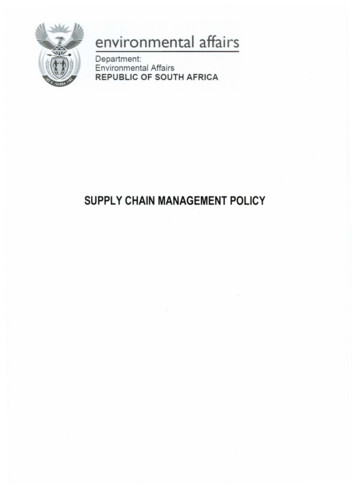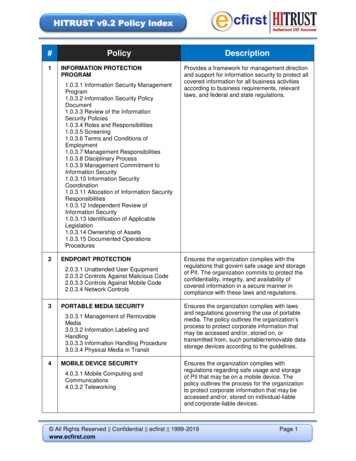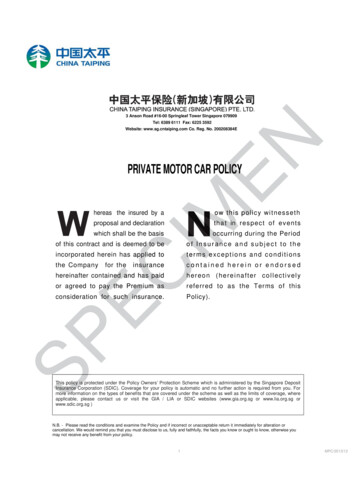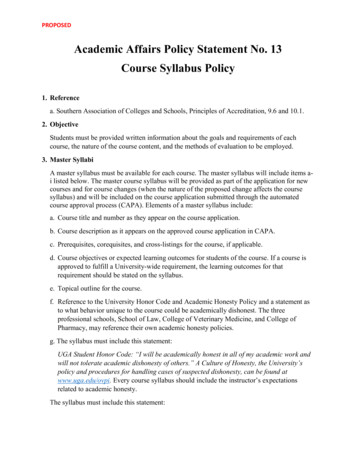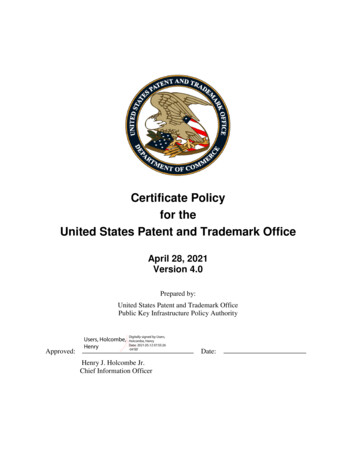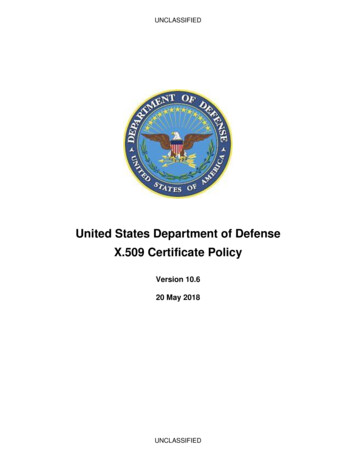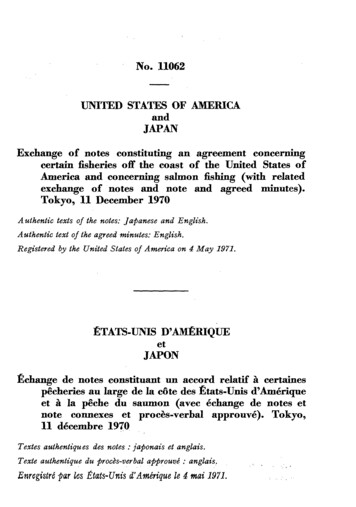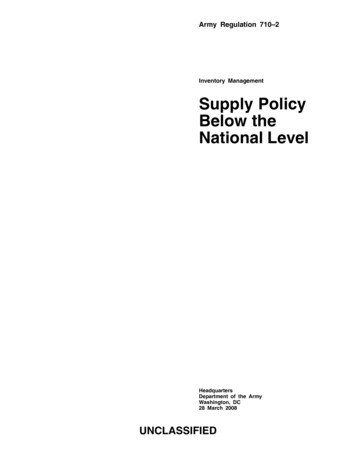
Transcription
Army Regulation 710–2Inventory ManagementSupply PolicyBelow theNational LevelHeadquartersDepartment of the ArmyWashington, DC28 March 2008UNCLASSIFIED
SUMMARY of CHANGEAR 710–2Supply Policy Below the National LevelThis rapid action revision, dated 28 March 2008-o Implements congressional approval of legislation allowing Soldiers to retainArmy combat uniforms issued as organizational clothing and individualequipment to deployers (para 2-56).o Makes administrative changes (throughout).
*Army Regulation 710–2HeadquartersDepartment of the ArmyWashington, DC28 March 2008Effective 28 April 2008Inventory ManagementSupply Policy Below the National LevelGuard/Army National Guard of the UnitedStates, and the U.S. Army Reserve, unlessotherwise stated. Also, it applies to the U.S. Army Reserve Officer Training Corps,and the National Defense Cadet Corps.During mobilization, the proponent maymodify chapters and policies contained inthis regulation.History. This publication is a rapid actionrevision. The portions affected by thisrapid action revision are listed in thesummary of change.Summary. This regulation updates supply policy below the national levelthroughout the U.S. Army. It is used inboth automated and manual supply operations. In an automated supply operation,this regulation is used in conjunction withthe appropriate automated procedural publication for the system being used. In amanual supply operation this regulation isused in conjunction with DA Pam710–2–1 and DA Pam 710–2–2.Proponent and exception authority.The proponent of this regulation is theDeputy Chief of Staff, G–4. The proponent has the authority to approve exceptions or waivers to this regulation that areconsistent with controlling law and regulations. The proponent may delegate thisapproval authority, in writing, to a division chief within the proponent agency orits direct reporting unit or field operatingagency, in the grade of colonel or thecivilian equivalent. Activities may requesta waiver to this regulation by providingjustification that includes a full analysis ofthe expected benefits and must includeformal review by the activity’s seniorlegal officer. All waiver requests will beendorsed by the commander or seniorleader of the requesting activity and forwarded through higher headquarters to thepolicy proponent. Refer to AR 25-30 forspecific guidance.This regulation contains management control provision and identifies key management controls that must be evaluated (seeappendix B).Supplementation. Supplementation ofthis regulation and establishment of command and local forms are prohibited without prior approval from the Deputy Chiefof Staff, G–4 (DALO–SUS), 500 ArmyPentagon, Washington, DC 20310–0500.Suggested improvements. Users areinvited to send comments and suggestedimprovements on DA Form 2028 (Recommended Changes to Publications andBlank Forms) directly to Director Logistics Transformation Agency (LOIA-AP),5870 21st Street, Fort Belvoir, VA22060–5941.Distribution. This publication is available in electronic media only and is intended for all command levels A, B, C, D,and E for the Active Army, the ArmyNational Guard/Army National Guard ofthe United States, and the U.S. ArmyReserve.Army management control process.Applicability. This regulation applies tothe Active Army, the Army NationalContents(Listed by paragraph and page number)Chapter 1General, page 1Section IIntroduction, page 1Purpose 1–1, page 1References 1–2, page 1Explanation of abbreviations and terms 1–3, page 1*This regulation supersedes AR 710–2, dated 8 July 2005.AR 710–2 28 March 2008UNCLASSIFIEDi
Contents—ContinuedSection IIResponsibilities, page 1Supply policy 1–4, page 1Organization 1–5, page 5The Uniform Materiel Movement and Issue Priority System 1–6, page 6Requests for clarification or deviation 1–7, page 6Waivers 1–8, page 6Reports of supply constraint (exempt from requirement control symbol under AR 335–15) 1–9, page 6Command Supply Discipline Program 1–10, page 7Supply excellence award program 1–11, page 7Property accountability 1–12, page 8Defense Property Accountability System (software program) 1–13, page 8Total package fielding 1–14, page 8Filing 1–15, page 9Implementation 1–16, page 9Section IIICommunication Security Equipment, page 10General information 1–17, page 10Communication security equipment management 1–18, page 10Inventories 1–19, page 13Section IVPerformance Standards, page 13General information 1–20, page 13Using unit or property book 1–21, page 13The supply support activity 1–22, page 15Section VDirect Support System and Air Line of Communication, page 17General Information 1–23, page 17Department of Defense activity address directory update 1–24, page 17Section VISecurity Classification of Logistics Data, page 17Division level and below 1–25, page 17Corps level 1–26, page 17Projections of on-hand data 1–27, page 17Section VIIHazardous Materials Management Program, page 18General information 1–28, page 18Major Army commands functions 1–29, page 18Supply support activity functions 1–30, page 18Using unit or activity functions 1–31, page 19Radio frequency total asset visibility property accounting procedures 1–32, page 19Army purchase card program 1–33, page 20Chapter 2Using Unit Supply (Organizational Supply Operations), page 20Section IGeneral Information, page 20Scope 2–1, page 20General organizational functions 2–2, page 20iiAR 710–2 28 March 2008
Contents—ContinuedFormat of using unit supply policy 2–3, page 20Section IIAccounting for and Controlling Property, page 20Property authorization documents 2–4, page 20Property book system 2–5, page 21Requesting supplies 2–6, page 25Followup of request for supplies 2–7, page 29Receiving supplies 2–8, page 29Asset reporting 2–9, page 30Assignment of property responsibility 2–10, page 31Storage of supplies 2–11, page 34Evaluations, inspections, and inventories 2–12, page 35Disposing of materiel 2–13, page 35Section IIIOrganization Clothing and Individual Equipment/Central Issue Facility, page 38Organization clothing and individual equipment/central issue facility management 2–14, page 38Classification and inspection standards for organization clothing and individual equipment 2–15, page 40Cash collection at central issue facilities 2–16, page 40Army National Guard management 2–17, page 40United States Army Reserve management 2–18, page 41Section IVManagement of loads, page 42Types of loads 2–19, page 42Basic and operational loads 2–20, page 42Prescribed loads 2–21, page 44Maintenance shop supply policy 2–22, page 46Shop stocks 2–23, page 46Bench stocks 2–24, page 48Army National Guard management of loads 2–25, page 49United States Army Reserve management of loads 2–26, page 49Section VReserve Officers Training Corps and National Defense Cadet Corps, page 50Responsibilities of educational institutions hosting the Army’s Senior and/or Junior Reserve Officers’ Training Corps/National Defense Cadet Corps programs 2–27, page 50Accounting for property 2–28, page 51Authorization data 2–29, page 51Requesting and receiving Army property 2–30, page 51Disposition of property 2–31, page 51Accounting for organization clothing and individual equipment 2–32, page 52Section VISpecial Accounting Policy, page 52Property purchased by ordering officers or activity contracting officers 2–33, page 52Family housing furnishings and unaccompanied personnel housing furnishings 2–34, page 52Other special accounting policy 2–35, page 52Section VIIPetroleum Management, page 56General 2–36, page 56Bulk petroleum and packaged fuels accountability 2–37, page 56Automatic fuel dispensing system 2–38, page 58AR 710–2 28 March 2008iii
Contents—ContinuedFuel cards/keys 2–39, page 58Section VIIIAmmunition Management, page 60General 2–40, page 60Storage 2–41, page 60Security and transportation 2–42, page 61Training ammunition 2–43, page 61Ammunition basic and operational loads 2–44, page 62Requesting, receiving, and turning in ammunition 2–45, page 63Inventory 2–46, page 63Records and reports 2–47, page 64Amnesty program 2–48, page 64Section IXWartime Policy, page 64General information 2–49, page 64Requesting and receiving property 2–50, page 64Disposition of property 2–51, page 64Accounting for property 2–52, page 65Assigning responsibility for property 2–53, page 65Controlling components 2–54, page 65Accounting for quarters furnishings 2–55, page 65Organizational clothing and individual equipment 2–56, page 65Special accounting policy 2–57, page 65Management of loads 2–58, page 65Inspections and inventories 2–59, page 65Wartime policy (ammunition) 2–60, page 66Section XMilitary Operations Other Than War, page 66Accounting policy for equipment and supplies used in military operations other than war by deploying, deployed, orsupport activities at the retail level 2–61, page 66Force building for task forces or other force building 2–62, page 69Chapter 3Direct Support and General Support Activities, page 76Section IGeneral, page 76Introduction 3–1, page 76General information 3–2, page 76Section IIInventory Control, page 77Inventory control functions 3–3, page 77Cataloging 3–4, page 77Distribution 3–5, page 77Disposal 3–6, page 77Section IIISupply Control, page 77Supply control functions 3–7, page 77Stockage selection 3–8, page 77Stockage level 3–9, page 79Petroleum 3–10, page 84ivAR 710–2 28 March 2008
Contents—ContinuedSelf-service supply center (outside continental United States only) 3–11, page 85Operational readiness float 3–12, page 85Cannibalization points 3–13, page 85Repairable management 3–14, page 85Replenishment requisitioning 3–15, page 87Customer requests 3–16, page 87Direct vender delivery 3–17, page 88Defense Reutilization and Marketing Office 3–18, page 88Local purchase (outside continental United States) 3–19, page 88Reconciliation and validation 3–20, page 88Receipt processing 3–21, page 89Pseudoreceipts 3–22, page 92Storage operations 3–23, page 93Inventory and adjustment 3–24, page 93Issues 3–25, page 95Material returns policy 3–26, page 96Shipping 3–27, page 99Section IVStock Control, page 100Stock record function 3–28, page 100Stock record account 3–29, page 100Stock record account files 3–30, page 100Asset reporting 3–31, page 102Section VAmmunition Management, page 104General 3–32, page 104Stockage 3–33, page 104Storage 3–34, page 105Security and transportation 3–35, page 105Receiving ammunition 3–36, page 105Inventory and inspections 3–37, page 106Records and reports 3–38, page 106Customer support 3–39, page 106Amnesty program 3–40, page 107Section VIWartime Policies, page 108General wartime policy 3–41, page 108Wartime policy modifications 3–42, page 108Wartime policy (ammunition) 3–43, page 108Chapter 4Supply Support for Installations, U.S. Property Fiscal Offices, Strategic Communications Facility, andTable of Distribution and Allowances Activities, page 109Section IGeneral, page 109Introduction 4–1, page 109General information 4–2, page 109Section IIInventory Control, page 109Inventory control functions 4–3, page 109Cataloging 4–4, page 109AR 710–2 28 March 2008v
Contents—ContinuedDistribution 4–5, page 111Disposal 4–6, page 111Section IIISupply Control, page 111Supply control functions 4–7, page 111Stockage selection 4–8, page 111Stockage levels 4–9, page 112Repairables stockage 4–10, page 113Customer requests 4–11, page 114Requisitioning 4–12, page 115Operational readiness float 4–13, page 115Solid fuels 4–14, page 115Self–service supply center 4–15, page 116Local purchase 4–16, page 118Defense Reutilization and Marketing Office 4–17, page 119Mission supply support activity 4–18, page 119Area maintenance and supply facilities 4–19, page 119Installation materiel maintenance activities 4–20, page 119Petroleum (bulk) 4–21, page 119Maintenance contracts 4–22, page 121Reconciliation and validation 4–23, page 121Receipt processing 4–24, page 122Bulk fuel receipts 4–25, page 124Pseudoreceipts 4–26, page 124Storage operations 4–27, page 125Inventory and adjustment 4–28, page 125Petroleum quality surveillance 4–29, page 128Issues 4–30, page 128Material returns policy 4–31, page 128Cannibalization points 4–32, page 129Automatic return items 4–33, page 130Disposition of petroleum products 4–34, page 130Repairable management 4–35, page 130Shipping 4–36, page 131Section IVStock Control, page 132Stock record accounts 4–37, page 132Stock record account files 4–38, page 132Special purpose stock record accounts 4–39, page 134In-transit aircraft refueling 4–40, page 135Asset reporting 4–41, page 136Ammunition management 4–42, page 138Chapter 5Corps Support Command and Theater Support Command, page 139Section IPolicy, page 139Introduction 5–1, page 139General information 5–2, page 139Section IIInventory Control, page 140viAR 710–2 28 March 2008
Contents—ContinuedInventory control functions 5–3, page 140Cataloging 5–4, page 140Distribution 5–5, page 141Disposal 5–6, page 141Section IIISupply Control, page 141Supply control functions 5–7, page 141Stockage selection 5–8, page 141Petroleum 5–9, page 141Self-service supply center 5–10, page 142Operational readiness float 5–11, page 142Cannibalization point 5–12, page 142Repairable management 5–13, page 142Replenishment requisitioning 5–14, page 143Customer requisitions 5–15, page 143Local purchase (outside continental United States only) 5–16, page 145Reconciliation and validation 5–17, page 145Receipt processing 5–18, page 145Pseudoreceipts 5–19, page 146Storage operations 5–20, page 147Inventory and adjustment 5–21, page 147Issues 5–22, page 148Theater Support Command materiel management center/Corps Support Command material returns 5–23, page 148Disposition of excess petroleum, oils, and lubricants 5–24, page 149Shipping 5–25, page 149Section IVStock Control, page 150Stock control function 5–26, page 150Stock record account 5–27, page 150Stock record account files 5–28, page 150Asset reporting 5–29, page 151Section VAmmunition Management, page 154Stockage 5–30, page 154Amnesty program 5–31, page 154Section VIWartime Policies, page 154Implementation 5–32, page 154Wartime policy modifications 5–33, page 155Corps Support Command/Theater Support Command wartime stockage 5–34, page 155Corps Support Command/Theater Support Command stock replenishment 5–35, page 155Wartime policy (ammunition) 5–36, page 156Chapter 6Theater Army Level Supply Management, page 156Section IPolicy, page 156Introduction 6–1, page 156Theater Support Command Materiel Management Center mission 6–2, page 156Asset visibility 6–3, page 156AR 710–2 28 March 2008vii
Contents—ContinuedDistribution system 6–4, page 156Section IIInventory Control, page 157General 6–5, page 157Cataloging 6–6, page 157Section IIISupply Control, page 158Requirements computation 6–7, page 158Sustainment requisitioning 6–8, page 160Requisition processing for supported activities 6–9, page 161Reconciliation and validation 6–10, page 161Receipt processing 6–11, page 162Storage operations 6–12, page 162Inventory and adjustment 6–13, page 162Issues 6–14, page 163Materiel return policy 6–15, page 163Shipping 6–16, page 164Decrement stock 6–17, page 164Theater operational readiness float 6–18, page 165Solid fuels 6–19, page 165Section IVStock Control, page 166General 6–20, page 166Asset reporting 6–21, page 167Section VAmmunition Management, page 170Stockage 6–22, page 170Requesting, receiving, and issuing ammunition 6–23, page 170Amnesty program 6–24, page 170Basic policy 6–25, page 170Wartime policy modifications 6–26, page 170Wartime policy (ammunition) 6–27, page 171Section VIWithdrawal, Diversion, and Temporary Loan of Reserve Component, page 171Introduction 6–28, page 171Withdrawal or diversion of Army National Guard and United States Army Reserve equipment 6–29, page 171AppendixesA.References, page 173B.Command Supply Discipline Program, page 185C.Petroleum Quality Surveillance and Technical Assistance Program, page 260D.Petroleum Resource Recovery, Recycling, and Disposal Program, page 266E. Sales of Petroleum Products, page 268F. Procedures for Hand Receipt Holders, page 271G. Chief of Staff, Army Supply Excellence Award, page 273viiiAR 710–2 28 March 2008
Contents—ContinuedTable ListTable 1–1: Classes of supply, page 6Table 1–2: Unit performance standards, page 14Table 1–3: SSA performance standards, page 16Table 2–1: Obtaining petroleum products for DA aircraft*, page 59Table 2–2: Type of inventories and discrepancies, page 71Table 3–1: ASL stockage, page 79Table 3–2: Dollar cost banding for aviation (same for non-division, missile), page 82Table 3–3: Dollar cost banding for DOL, page 82Table 3–4: Dollar cost banding for a forward unit, page 83Table 3–5: Dollar cost banding for the main (same for non-division), page 84Table 4–1: Disposition of excess, page 138Table 4–2: Disposition of excess, page 139Table 5–1: Accuracy edits, page 144Table 5–2: Available edits, page 145Table B–1: User level, page 189Table B–2: Property book officer level, page 204Table B–3: Parent organization level, page 212Table B–4: Direct and general support supply operations, page 218Table B–5: Supply support for installations, U.S. property fiscal office, strategic communications facility, TDAactivities, and supply units or activities providing general support to DSU supply operations, page 240Table B–6: ACOM/ASCC/DRU level, page 254Table B–7: CSDP Evaluation frequency*, page 258Table C–1: Fuels used in Army equipment, page 264Table C–2: NATO fuel designators and U.S. equipment specifications and standards, page 265Table G–1: Milestones, page 277GlossaryAR 710–2 28 March 2008ix
Chapter 1GeneralSection IIntroduction1–1. PurposeThis regulation prescribes policy for supply operations below the national level. It applies in peace and war. Specifically, this regulation—a. Provides specific policy for the accountability and assignment of responsibility for property issued to a using unit.It also provides for the accountability and management of stocks being stored at direct, general, or installation supplysupport activities (SSAs) for issue to a customer. The management and accountability must include automaticidentification technologies (AIT), such as bar code, 2D bar code, optical memory cards, radio frequency identification(RFID) tags, contact buttons, or satellite tracking. All stocks will be AIT enabled from vendor to the war-fighter andreturn.b. Unless specified by the prescribing directive, this regulation does not apply when accounting for the following:(1) Armed Forces Radio and Television Service program materials using Army Regulation (AR) 360–1.(2) Library books and materials using AR 27–1, AR 40–2, or AR 735–17.(3) Nonappropriated fund (NAF) assets using Department of Defense (DOD) 7000.14–R.(4) Publications and blank forms using AR 25–1 and AR 25–30.(5) Real property and facilities engineering resources using AR 420–18.(6) Special purpose equipment using a classified AR.(7) Visual information products using AR 25–1.(8) Historical property and museum pieces using AR 870–20.(9) Army National cemetery property and supplies using AR 290–5. This exclusion does not apply to material thatcould have other Army-wide applications.(10) The Army Art Collection using AR 870–20.(11) Industrial property and equipment in place using Defense Financial Accounting System Instruction (DFAS–IN)Regulation 37–1.(12) Clothing initial issue point (CIIP) stocks using AR 700–84.(13) Communications security (COMSEC) key software and publicat
Army National Guard management 2–17, page 40 United States Army Reserve management 2–18, page 41 Section IV Management of loads, page 42 Types of loads 2–19, page 42 Basic and operational loads 2–20, page 42 Prescribed loads 2–21, page 44 Maintenance shop supply policy 2–22, page 46 Shop stocks 2–23 .


